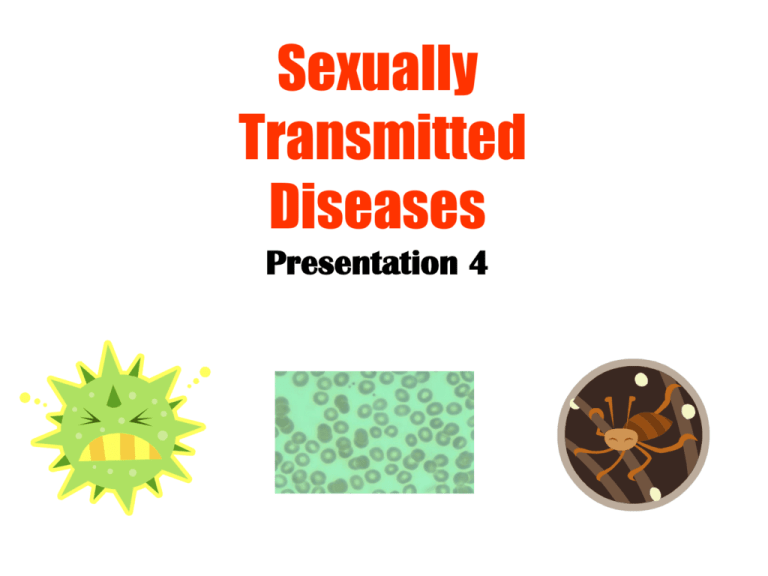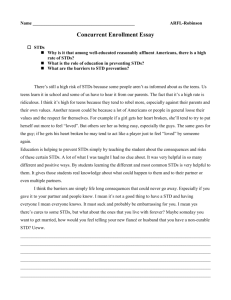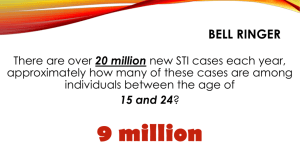
Sexually
Transmitted
Diseases
Presentation 4
Health I.Q. (True/False)
Number your paper 1-10.
1. Newborn babies are given medicated eye drops to
prevent blindness due to a gonorrhea-infected mother.
2. It’s best to see if an STD goes away on its own before
going to a doctor.
3. Washing the genitals after sex prevents STDs.
4. People aged 15-24 have the highest rate of chlamydia.
5. An itchless rash on the hands is a symptom of syphilis.
6. Birth-control pills prevent STDs.
7. The medicine prescribed for one kind of STD will cure
any STD.
8. If one sex partner is treated for an STD, the other
partner does not need to be treated.
9. Some STDs do not have any symptoms and can only be
detected by lab tests.
10. Three of the most common STDs in the US are
trichomoniasis, human papilloma virus, and chlamydia.
Health I.Q. Answers
1. TRUE: Newborn babies are routinely given
medicated eye drops to prevent blindness
from a gonorrhea-infected mother.
2. FALSE: It’s best to see if an STD goes away
on its own before going to a doctor. MOST
WILL NOT GO AWAY ON THEIR OWN.
3. FALSE: Washing the genitals after sex
prevents STDs. WASHING IS NOT AN
EFFECTIVE WAY TO PREVENT STDs.
4. TRUE: People aged 15-24 have the highest
rate of chlamydia.
5. TRUE: An itchless rash on the hands is a
symptom of syphilis.
Health I.Q. Answers
6. FALSE: Birth-control pills prevent STDs. THEY
DO NOT PREVENT STDs.
7. FALSE: The medicine prescribed for one kind of
STD will cure any STD. EACH STD REQUIRES
A DIFFERENT TREATMENT.
8. FALSE: If one sex partner is treated for an STD,
the other partner does not need to be treated.
BOTH MUST TREATED SO THEY DO NOT
REINFECT ONE ANOTHER.
9. TRUE: Some STDs do not have any symptoms
and can only be detected by lab tests.
10. TRUE: Three of the most common STDs in the
US are trichomoniasis, human papilloma virus,
and chlamydia.
Basic Information
Some STDs can be fatal. Others
have symptoms that are mild or
unnoticeable.
If untreated, all STDs eventually
harm a person’s health.
How are STDs Spread?
Sexually Transmitted Diseases can be spread
by:
1. Any type of sexual activity that brings an
uninfected person in contact with body
fluids from an infected person.
2. Any sexual activity that results in contact
between one person’s genitals and
another person’s skin or mucous
membranes, in which one of the persons
is already infected with an STD.
3. Direct contact with open sores.
4. An infected mother to her baby before
birth, during birth, or during breastfeeding.
Two Kinds of Sexual
Transmission
• 1) Skin to Skin
Infected/ + Contact with
infested
susceptible
skin
skin
• 2) Body Fluid
S-S
transmission
BF
N
Body Fluid
+ Entry into Body transmission
(blood, semen,
(needle, open
vaginal fluids
skin, mucous
& breast milk)
membrane)
STD Transmission
S-S
BF
• Genital Herpes
• Genital Warts (HPV)
• Syphilis
• Chlamydia
• Gonorrhea
• HIV
• Pubic Lice
• Scabies
• Hepatitis A
• Hepatitis B
• Hepatitis C
Mistaken Ideas
• In most cases, the bacteria and viruses
that cause STDs cannot survive
outside of the human body.
• Most of the bacteria and viruses that
cause STDs cannot be spread through:
– Kissing, sharing eating utensils, holding
hands, or using public toilets.
• Not all STDs can be treated and cured.
– Some, such as herpes are permanent.
Permanent Damage…
• All STDs can harm a person’s health
and cause permanent damage.
– Some STDs result in painful sores that
can recur throughout one’s life.
– Some STDs can lead to brain damage or
cancer.
– Some STDs can leave a person unable to
have children.
– Some STDs can even be fatal.
Class Activity
1. Students will be handed a 3x5 card or slip
of paper.
2. With a pen/pencil and card/paper in hand,
students will move about the classroom
shaking hands or give fist bumps with 5
people making sure to write the name of
each person they shook hands with on the
card.
3. Once you have 5 names on your card
return to your seat and sit quietly.
Class Activity Reflection
Take a minute and think about TV shows
and movies you may watch.
• How often do people on TV/movies have
sex with more than one partner?
• Do they ever discuss waiting for sex until
they are ready to make a commitment?
• What are some examples?
• Were the consequences shown or
discussed?
STDs: The Silent Epidemic
• An epidemic is the occurrence of more cases of
a disease than expected.
• STDs are said to be a “silent epidemic” among
teens and young adults.
• Many STDs are asymptomatic, which means
you can have the disease without any
symptoms.
• When there are no symptoms, a person may
spread the disease without knowing it.
• Sexually active people should undergo regular
testing for STDs at least once a year.
What’s going on in Clark County?
• The rate of chlamydia in 2009 was 304
cases per 100,000 residents.
• The overall incidence of chlamydia
infections in women 15-24 in 2008 was
2,198 infections per 100,000 females
• The rate of gonorrhea for both genders
was 28.8 cases per 100,000 residents.
• As of 12/2009 there were 424 people living
with HIV or AIDS in our county.
Things you can do to protect
yourself from STDs include:
1. practicing abstinence
2. staying away from alcohol and drugs
3. respecting yourself
4. learning the facts about
STDs
Study Tip!
•Pay attention to what the MAIN
symptoms are for each STD
•Pay attention to TREATMENT options
or if there is none for each STD
STDs Caused by Bacteria
Gonorrhea, Syphilis
Chlamydia, and Pelvic
Inflammatory Disease (PID),
Bacterial STDs: pelvic
inflammatory disease
•PID= infection of the upper female reproductive tract.
•Symptoms:
•Pain in the pelvic area or abdomen
•Vaginal discharge
•Unusually long/painful menstrual periods
•Spotting between periods
Ectopic
Pregnancy
•Fever and painful urination
•Treatment: antibiotics are used to treat PID, but it
does not repair damage that has already occurred.
•If untreated scars on the fallopian tubes or uterus
can lead to infertility or ectopic pregnancies = egg
implants outside of uterus usually in fallopian tube. Dangerous!
Bacterial STDs: GONORRHEA
•Gonorrhea is an STD caused by bacteria.
•Symptoms in Females:
•Often no obvious symptoms
•Pain during urination
•Vaginal discharge or bleeding
•Symptoms in Males:
•Pain during urination
Eyedrops are given at birth to
prevent blindness caused by STDs
passed from mother to newborn.
•Discharge from the penis
•Treatment: Both partners take antibiotics at the same
time.
•Gonorrhea is becoming more difficult to treat
because the bacteria that cause it have become more
resistant to antibiotics.
Bacterial STDs: Syphilis
•Syphilis is an STD caused by bacteria
that can cause ulcers or chancres
(pronounced: shānker).
•Symptoms in both males and
females:
•Painless ulcer, called a chancre
•Treatment: Both partners take
antibiotics at the same time.
•If treated in the early stages, syphilis
can be cured.
Bacterial STDs: chlamydia
•Chlamydia is an STD caused by bacteria.
•Symptoms in Males & Females:
•Often no symptoms
•Pain during urination
•Vaginal discharge or bleeding (FEMALES only)
•Discharge from the penis (MALES only)
•Treatment: Both partners take antibiotics at the same
time.
•The highest rates of chlamydia infections in the
United States are found in 15-19 year olds.
•There are more new cases of chlamydia than any
other STD reported each year in the U.S.
STDs Caused by Viruses
human papilloma virus (HPV),
genital herpes, hepatitis,
human immuno-deficiency virus
(HIV)
viral STDs:
Human papilloma virus (HPV)
•HPV is an STD caused by a group of viruses that can cause
genital warts in males and females and cervical cancer in
females.
•Symptoms in both males and females:
•Often no symptoms
•Genital and anal warts
HPV Treatment
• Treatment: THERE IS NO CURE.
• However, there’s a vaccine that prevents the types of genital
(HPV) that cause most cases of cervical cancer and genital
warts. The vaccine, Gardasil®, is given in three shots over
six-months. The vaccine is routinely recommended for 11
and 12 year old girls. It is also recommended for girls and
women age 13 through 26 who have not yet been vaccinated
or completed the vaccine series.
• In a 4 year study 31% of 14-19 year-old girls successfully
completed all 3 doses.
• Warts can be treated, but will often return.
• Both males and females have a higher risk of developing
genital cancers.
• HPV is responsible for more new STD cases than any
other STD in the U.S. (all ages).
viral STDs: genital herpes
•Genital Herpes is an STD caused by a viral infection in the
genital area.
•It is caused by the herpes simplex virus (HSV).
•There are 2 types of HSV: HSV-1 and HSV-2.
•Most cases of genital herpes are HSV-2.
•Both types can be passed from mother to newborn during birth
if the mother has genital sores at that time.
•Symptoms in both males and females:
•HSV-1: cold sores and fever blisters around the mouth
*Many people with cold sores DO NOT have an STD.*
•HSV-2: mild/no symptoms, red bumps, blisters and
recurrent sores on or around the genitals
•Treatment: THERE IS NO CURE. Antiviral medications can
shorten outbreaks and reduce their frequency.
•An infected person remains infected for life.
viral STDs:
Hepatitis B & C
• The Hepatitis B virus attacks the liver and can cause
illness and death.
• It’s transmitted when blood or other body fluids from an
infected person enters the body of a person who has not
been vaccinated against it.
• 30% of people with HBV have no symptoms.
• Symptoms can include: jaundice, fatigue, abdominal
pain, nausea/vomiting, joint pain, and loss of appetite.
• 40% of those who get it can be treated with drugs.
• Hepatitis C is quite similar, but there is no vaccine or
cure for it.
Hepatitis B
STDs Caused by Parasites
pubic lice, scabies, and
trichomoniasis
parasitic STDs: pubic lice
•Pubic lice are a strain of lice found in
pubic hair of those infected. The lice
are spread by skin-to-skin contact.
•Symptoms in both males and
females:
•Can cause intense itching in the
pubic area
•Treatment: Medication can kill the
lice. An infected person must wash
clothes and bed linens in hot water to
kill any remaining lice and their eggs.
•BOTH PARTNERS MUST BE TREATED
TO PREVENT RE-INFECTION.
parasitic STDs: Scabies
•Is an STD caused by a protozoan, a single-celled
animal that is just a little larger than a bacterium.
•Spread by skin-to-skin contact.
•Symptoms in females:
•Itching in the genital area
•Discharge from the vagina
•Painful urination
•Symptoms in males:
•Usually no symptoms
•Treatment: Can be cured
with prescribed medicine.
•BOTH PARTNERS MUST BE TREATED TO PREVENT RE-INFECTION.
parasitic STDs: trichomoniasis
•Trichomoniasis is an STD caused by a protozoan
(= a single celled organism).
•Symptoms in females:
•itching in the genital area.
•discharge from the vagina
•painful urination
•Symptoms in males:
•usually no symptoms
•Treatment: It can be cured with a prescribed
medicine.
Being responsible about STDs
People who are sexually
active must get
screened regularly.
People who think they
might have a sexually
transmitted disease
should do the
following:
1. Seek medical help
right away.
2. Complete the full
course of
medications.
3. Have follow-up
testing done.
4. Avoid all sexual
activity while being
treated.
5. Notify sexual
partners.
Words of wisdom
• STDs can affect ANYONE.
• Your behavior now will affect you the rest
of your life.
• It is important to understand and avoid
behavior that places you at risk for
contracting a STD.
• Practicing abstinence is the ONLY sure
way to prevent STDs.
HIV/STD HOTLINE
(206) 205-7837
1 800 227 8922
Presentation Resources
• This presentation was created using one or
more of the following curricula:
–
–
–
–
–
–
–
–
Department of Health, online resources
Center for Disease Control, online resources
F.L.A.S.H. (Family Life and Sexual Health)
Glencoe Health, 2007
Glencoe Human Sexuality 2007
Holt Lifetime Health 2004
KNOW (HIV/STD Prevention) 1997
Prentice Hall Health, 2007







